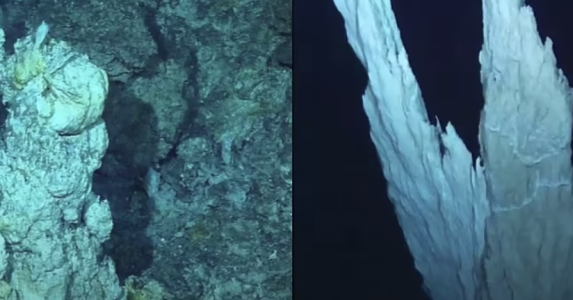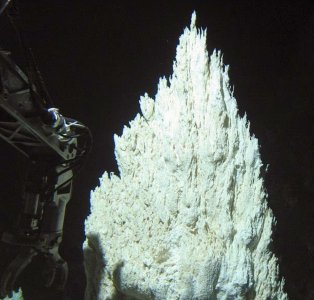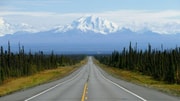Have scientists just uncovered the real origin of life in this strange undersea world?
By
Veronica E.
- Replies 0
Deep beneath the Atlantic Ocean lies a hidden landscape that scientists describe as “otherworldly.”
Known as the Lost City, this mysterious site features towering, mineral-rich spires more than 2,300 feet below sea level.
It’s not a myth or sunken civilization, but a natural formation that operates unlike anything else on Earth.
What makes it so remarkable is that it may offer real clues about how life first began.
Some researchers even believe it could help us understand how life might exist beyond our planet.

No humans ever lived here—just microbes, minerals, and mystery
The Lost City isn’t a sunken civilization or a relic from ancient humanity like the mythical Atlantis.
Instead, it’s a natural geological formation located near the Mid-Atlantic Ridge, a mountain range that runs through the ocean floor.
Here, water seeps through cracks in the Earth’s crust and meets super-hot rock from the mantle, triggering a process called serpentinization.
This process doesn’t involve volcanic activity like most hydrothermal vent systems.
Instead, it creates chemical reactions that release hydrogen and methane—gases that serve as food for tiny microbes living in the darkness.
These gases help support a rare, lightless ecosystem built entirely on chemistry instead of sunlight.
Also read: Cruise ship insider reveals secrets: What REALLY goes on in the middle of the ocean!
A window into early Earth—and maybe into space
What makes the Lost City so exciting for scientists is how closely it resembles the environment of early Earth.
The hydrocarbons formed there are the same kinds of molecules thought to be building blocks of life.
That’s why researchers believe the Lost City could be a natural laboratory—a place to study how life may have first emerged from simple chemistry billions of years ago.
In fact, recent drilling efforts recovered rock samples from the mantle itself, offering scientists rare access to the deep Earth and the powerful processes taking place there.
Also read: Scientists spot terrifying "Black Seadevil" in shallow water—see the rare creature before it vanishes again!
A thriving community without sunlight
Despite the harsh, pitch-black conditions, life exists in this deep-sea environment.
Temperatures inside the spires can reach nearly 200°F, yet microbes thrive by feeding on methane and hydrogen.
These microscopic organisms are joined by larger creatures like shrimp, snails, and eels—species specially adapted to survive where there’s no sunlight and no plants.
Unlike coral reefs, which depend on photosynthesis and a food chain fueled by the sun, the Lost City’s residents rely on chemical energy alone.
It’s a fragile but thriving ecosystem—one that shows just how adaptable life can be.

Also read: What lurks 2,000 feet below? The cameras just found out!
Could similar life exist on other planets?
The discovery has sparked more than just curiosity about Earth’s past.
Some scientists believe places like the Lost City may exist elsewhere in the solar system.
For example, the icy moons Europa and Enceladus—circling Jupiter and Saturn—are thought to have liquid oceans beneath their frozen surfaces.
If hydrothermal vents are present there, similar chemical reactions could be taking place right now.
Microbiologist William Brazelton, who has studied the Lost City, points out that these findings could guide the search for life beyond Earth.
If life can survive in such an extreme environment here, perhaps it can do so elsewhere too.

Also read: Watch this teen's terrifying encounter with a great white shark—and how he escaped!
But it’s not safe from human impact
Even though it’s miles away from land, the Lost City isn’t beyond reach.
In 2017, Poland received a 15-year license from the International Seabed Authority to explore nearby regions for deep-sea mining.
While the Lost City itself isn’t rich in valuable metals, surrounding areas are—and mining activity could disturb sediment and release pollutants that harm this delicate system.
The site has already been recognized by the Convention on Biological Diversity as an “Ecologically or Biologically Significant Marine Area,” and UNESCO is currently considering it for World Heritage status.
But as of now, those protections remain voluntary—not enforceable by law.
For many of us, especially those who’ve seen decades of scientific discovery unfold, the Lost City is a reminder of how much mystery still lies beneath the surface—literally.
It’s a place where life doesn’t need light, where chemistry powers entire communities, and where ancient processes may offer insight into the origin of life itself.
As we look to the stars and wonder whether we’re alone in the universe, perhaps the first answers still lie right here—hidden in the deepest corners of our own planet.
Read next: Discover the ancient gateway that still whispers tales of the Titanic tragedy–you won’t believe what else it’s seen!

Have you ever visited a natural wonder that left you speechless? What do you think of the Lost City’s potential for revealing life’s origins—or pointing to life beyond Earth? Join the conversation below and let us know your thoughts!
Known as the Lost City, this mysterious site features towering, mineral-rich spires more than 2,300 feet below sea level.
It’s not a myth or sunken civilization, but a natural formation that operates unlike anything else on Earth.
What makes it so remarkable is that it may offer real clues about how life first began.
Some researchers even believe it could help us understand how life might exist beyond our planet.

An undersea site may hold clues to the origins of life and the search for life beyond Earth. Image Source: YouTube / LGNews.
No humans ever lived here—just microbes, minerals, and mystery
The Lost City isn’t a sunken civilization or a relic from ancient humanity like the mythical Atlantis.
Instead, it’s a natural geological formation located near the Mid-Atlantic Ridge, a mountain range that runs through the ocean floor.
Here, water seeps through cracks in the Earth’s crust and meets super-hot rock from the mantle, triggering a process called serpentinization.
This process doesn’t involve volcanic activity like most hydrothermal vent systems.
Instead, it creates chemical reactions that release hydrogen and methane—gases that serve as food for tiny microbes living in the darkness.
These gases help support a rare, lightless ecosystem built entirely on chemistry instead of sunlight.
Also read: Cruise ship insider reveals secrets: What REALLY goes on in the middle of the ocean!
A window into early Earth—and maybe into space
What makes the Lost City so exciting for scientists is how closely it resembles the environment of early Earth.
The hydrocarbons formed there are the same kinds of molecules thought to be building blocks of life.
That’s why researchers believe the Lost City could be a natural laboratory—a place to study how life may have first emerged from simple chemistry billions of years ago.
In fact, recent drilling efforts recovered rock samples from the mantle itself, offering scientists rare access to the deep Earth and the powerful processes taking place there.
Also read: Scientists spot terrifying "Black Seadevil" in shallow water—see the rare creature before it vanishes again!
A thriving community without sunlight
Despite the harsh, pitch-black conditions, life exists in this deep-sea environment.
Temperatures inside the spires can reach nearly 200°F, yet microbes thrive by feeding on methane and hydrogen.
These microscopic organisms are joined by larger creatures like shrimp, snails, and eels—species specially adapted to survive where there’s no sunlight and no plants.
Unlike coral reefs, which depend on photosynthesis and a food chain fueled by the sun, the Lost City’s residents rely on chemical energy alone.
It’s a fragile but thriving ecosystem—one that shows just how adaptable life can be.

A haunting view of the Lost City hydrothermal field, where towering mineral chimneys rise from the ocean floor—offering scientists a rare glimpse into Earth’s ancient past and the potential origins of life. Image Source: The Daily Mail / NSF, NOAA, University of Washington.
Also read: What lurks 2,000 feet below? The cameras just found out!
Could similar life exist on other planets?
The discovery has sparked more than just curiosity about Earth’s past.
Some scientists believe places like the Lost City may exist elsewhere in the solar system.
For example, the icy moons Europa and Enceladus—circling Jupiter and Saturn—are thought to have liquid oceans beneath their frozen surfaces.
If hydrothermal vents are present there, similar chemical reactions could be taking place right now.
Microbiologist William Brazelton, who has studied the Lost City, points out that these findings could guide the search for life beyond Earth.
If life can survive in such an extreme environment here, perhaps it can do so elsewhere too.

A surreal stretch of the deep sea, the Lost City’s towering chimneys offer scientists a rare look into ancient Earth—and a possible blueprint for life in the cosmos. Image Source: The Daily Mail / D. Kelley/ M. Elend/UW/URI-IAO/NOAA/The Lost City Science Team.
Also read: Watch this teen's terrifying encounter with a great white shark—and how he escaped!
But it’s not safe from human impact
Even though it’s miles away from land, the Lost City isn’t beyond reach.
In 2017, Poland received a 15-year license from the International Seabed Authority to explore nearby regions for deep-sea mining.
While the Lost City itself isn’t rich in valuable metals, surrounding areas are—and mining activity could disturb sediment and release pollutants that harm this delicate system.
The site has already been recognized by the Convention on Biological Diversity as an “Ecologically or Biologically Significant Marine Area,” and UNESCO is currently considering it for World Heritage status.
But as of now, those protections remain voluntary—not enforceable by law.
For many of us, especially those who’ve seen decades of scientific discovery unfold, the Lost City is a reminder of how much mystery still lies beneath the surface—literally.
It’s a place where life doesn’t need light, where chemistry powers entire communities, and where ancient processes may offer insight into the origin of life itself.
As we look to the stars and wonder whether we’re alone in the universe, perhaps the first answers still lie right here—hidden in the deepest corners of our own planet.
Read next: Discover the ancient gateway that still whispers tales of the Titanic tragedy–you won’t believe what else it’s seen!
Key Takeaways
- The Lost City is a unique deep-sea hydrothermal field in the Atlantic Ocean, featuring towering carbonate spires formed over 120,000 years by chemical reactions—not volcanic heat.
- Instead of sunlight, life in the Lost City is fueled by gases like hydrogen and methane produced through reactions between seawater and the Earth’s mantle.
- These extreme conditions resemble early Earth and may help scientists understand how life began; they also offer clues about the potential for life on icy moons like Europa or Enceladus.
- Despite its remote location, the Lost City faces indirect threats from nearby deep-sea mining operations, prompting efforts to secure international protections like UNESCO World Heritage status.
Have you ever visited a natural wonder that left you speechless? What do you think of the Lost City’s potential for revealing life’s origins—or pointing to life beyond Earth? Join the conversation below and let us know your thoughts!






